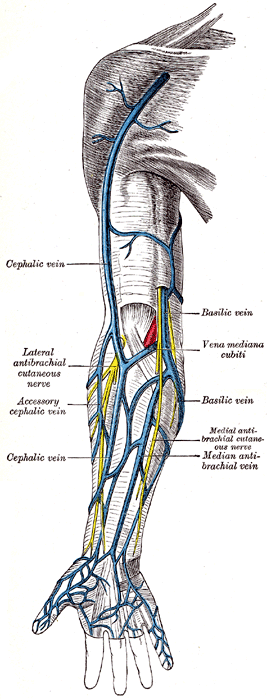Brachiocephalic vein
(Redirected from Brachiocephalic veins)
Brachiocephalic vein
The brachiocephalic veins (also known as innominate veins) are major veins of the thorax that return blood to the heart from the upper limbs, neck, and head. They are part of the venous system and are situated in the upper chest, one on each side of the body.
Structure[edit | edit source]
Each brachiocephalic vein is formed by the union of the internal jugular vein and the subclavian vein. The left brachiocephalic vein is usually longer than the right one and crosses the midline anterior to the aorta and posterior to the sternum. The right brachiocephalic vein is typically shorter and runs a more vertical course.
Function[edit | edit source]
The brachiocephalic veins are responsible for draining oxygen-depleted blood from the upper half of the body and returning it to the heart. They also serve as a conduit for blood returning from the head and neck to the superior vena cava, which then empties into the right atrium of the heart.
Clinical significance[edit | edit source]
Due to their location and size, the brachiocephalic veins are often used for the insertion of central venous catheters and for the measurement of central venous pressure, which can provide important information about a patient's cardiovascular system.
See also[edit | edit source]
References[edit | edit source]
Search WikiMD
Ad.Tired of being Overweight? Try W8MD's NYC physician weight loss.
Semaglutide (Ozempic / Wegovy and Tirzepatide (Mounjaro / Zepbound) available. Call 718 946 5500.
Advertise on WikiMD
|
WikiMD's Wellness Encyclopedia |
| Let Food Be Thy Medicine Medicine Thy Food - Hippocrates |
Translate this page: - East Asian
中文,
日本,
한국어,
South Asian
हिन्दी,
தமிழ்,
తెలుగు,
Urdu,
ಕನ್ನಡ,
Southeast Asian
Indonesian,
Vietnamese,
Thai,
မြန်မာဘာသာ,
বাংলা
European
español,
Deutsch,
français,
Greek,
português do Brasil,
polski,
română,
русский,
Nederlands,
norsk,
svenska,
suomi,
Italian
Middle Eastern & African
عربى,
Turkish,
Persian,
Hebrew,
Afrikaans,
isiZulu,
Kiswahili,
Other
Bulgarian,
Hungarian,
Czech,
Swedish,
മലയാളം,
मराठी,
ਪੰਜਾਬੀ,
ગુજરાતી,
Portuguese,
Ukrainian
Medical Disclaimer: WikiMD is not a substitute for professional medical advice. The information on WikiMD is provided as an information resource only, may be incorrect, outdated or misleading, and is not to be used or relied on for any diagnostic or treatment purposes. Please consult your health care provider before making any healthcare decisions or for guidance about a specific medical condition. WikiMD expressly disclaims responsibility, and shall have no liability, for any damages, loss, injury, or liability whatsoever suffered as a result of your reliance on the information contained in this site. By visiting this site you agree to the foregoing terms and conditions, which may from time to time be changed or supplemented by WikiMD. If you do not agree to the foregoing terms and conditions, you should not enter or use this site. See full disclaimer.
Credits:Most images are courtesy of Wikimedia commons, and templates, categories Wikipedia, licensed under CC BY SA or similar.
Contributors: Prab R. Tumpati, MD

